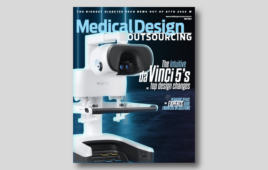
Professor Michael Cima and his colleagues are now designing brain implants that can not only deliver electrical stimulation but also record brain activity or deliver drugs to very targeted locations. [Image from Christine Daniloff/MIT]
Diseases like Parkinson’s disease can be treated with electrical stimulations from electrodes that have been implanted in the brain. Implanted electrodes, however, can cause scarring which can make the electrodes less effective and result in more surgeries to replace them.
“What we’re doing is changing the scale and making the procedure less invasive,” said Michael Cima, senior author on the study, in a press release.
Cima is now working with a team to develop electrodes that are much smaller that can deliver electrical stimulation, record brain activity and even deliver drugs to targeted locations.
The electrodes used for Parkinson’s disease treatment are a few millimeters in diameter. Once implanted, the electrodes generate scar tissue over time through rubbing against the surrounding brain tissues through a process called gliosis. Gliosis has been known to cause high failure rates of implanted devices. Half of the devices stop working within the first six months. Previous studies have shown that the smaller or softer the implant, less scarring will occur.
MIT researchers wanted to measure the effects of smaller implants while coating them with a soft polyethylene glycol (PEG) hydrogel. Hydrogel coatings have an elasticity that is similar to the brain. The researchers can also control how thick the PEG coating can be.
During the research, the coating on the electrodes would call off when pushed into the brain, so the researchers applied a layer of hydrogel and dried it so a hard, thin film would form. When the electrode was implanted, the film soaked up water and became soft again.
The researchers tested coated and uncoated glass fibers with different diameters in mice. They found that the coated fibers resulted in less scarring than the uncoated fibers that were the same size. If the electrode fibers were smaller, 30 microns small, the uncoated fibers could create less scarring because added coatings increase the diameter size.
“Before this paper, no one really knew the effects of size,” said Cima. “Softer is better, but not if it makes the electrode larger.”
Cima and his team are working to develop electrodes that are only 30 microns in diameter that can do electrical stimulation, drug delivery and record electrical activity in the brain. If successful, the devices could be used for treating Parkinson’s disease and other neurological disorders. It could also remove fluid from the brain to monitor if treatments are effective and measure brain activity to predict seizures.
“It’s one of those things that at first glance seems impossible. If you have 30-micron glass fibers, that’s slightly thicker than a piece of hair. But it is possible to do,” Cima said.
The research was published in the journal Scientific Reports and was funded by the National Institutes of Health and MIT’s Institute for Soldier Nanotechnologies.
[Want to stay more on top of MDO content? Subscribe to our weekly e-newsletter.]







